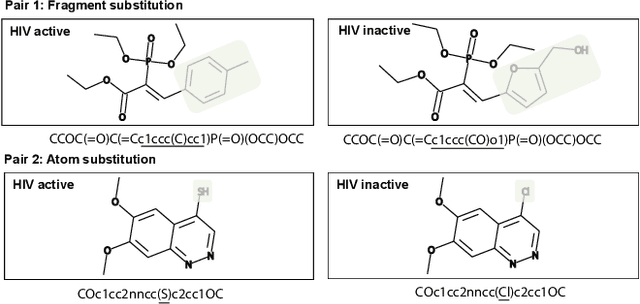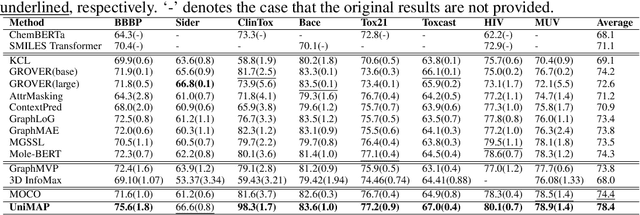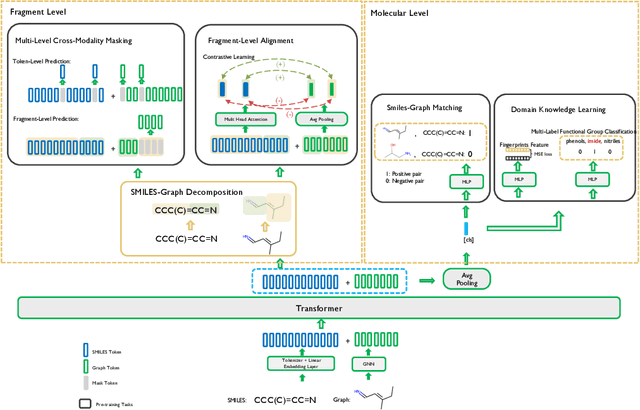Shikun Feng
Straight-Line Diffusion Model for Efficient 3D Molecular Generation
Mar 04, 2025Abstract:Diffusion-based models have shown great promise in molecular generation but often require a large number of sampling steps to generate valid samples. In this paper, we introduce a novel Straight-Line Diffusion Model (SLDM) to tackle this problem, by formulating the diffusion process to follow a linear trajectory. The proposed process aligns well with the noise sensitivity characteristic of molecular structures and uniformly distributes reconstruction effort across the generative process, thus enhancing learning efficiency and efficacy. Consequently, SLDM achieves state-of-the-art performance on 3D molecule generation benchmarks, delivering a 100-fold improvement in sampling efficiency. Furthermore, experiments on toy data and image generation tasks validate the generality and robustness of SLDM, showcasing its potential across diverse generative modeling domains.
UniGEM: A Unified Approach to Generation and Property Prediction for Molecules
Oct 14, 2024



Abstract:Molecular generation and molecular property prediction are both crucial for drug discovery, but they are often developed independently. Inspired by recent studies, which demonstrate that diffusion model, a prominent generative approach, can learn meaningful data representations that enhance predictive tasks, we explore the potential for developing a unified generative model in the molecular domain that effectively addresses both molecular generation and property prediction tasks. However, the integration of these tasks is challenging due to inherent inconsistencies, making simple multi-task learning ineffective. To address this, we propose UniGEM, the first unified model to successfully integrate molecular generation and property prediction, delivering superior performance in both tasks. Our key innovation lies in a novel two-phase generative process, where predictive tasks are activated in the later stages, after the molecular scaffold is formed. We further enhance task balance through innovative training strategies. Rigorous theoretical analysis and comprehensive experiments demonstrate our significant improvements in both tasks. The principles behind UniGEM hold promise for broader applications, including natural language processing and computer vision.
Pre-training with Fractional Denoising to Enhance Molecular Property Prediction
Jul 14, 2024Abstract:Deep learning methods have been considered promising for accelerating molecular screening in drug discovery and material design. Due to the limited availability of labelled data, various self-supervised molecular pre-training methods have been presented. While many existing methods utilize common pre-training tasks in computer vision (CV) and natural language processing (NLP), they often overlook the fundamental physical principles governing molecules. In contrast, applying denoising in pre-training can be interpreted as an equivalent force learning, but the limited noise distribution introduces bias into the molecular distribution. To address this issue, we introduce a molecular pre-training framework called fractional denoising (Frad), which decouples noise design from the constraints imposed by force learning equivalence. In this way, the noise becomes customizable, allowing for incorporating chemical priors to significantly improve molecular distribution modeling. Experiments demonstrate that our framework consistently outperforms existing methods, establishing state-of-the-art results across force prediction, quantum chemical properties, and binding affinity tasks. The refined noise design enhances force accuracy and sampling coverage, which contribute to the creation of physically consistent molecular representations, ultimately leading to superior predictive performance.
UniCorn: A Unified Contrastive Learning Approach for Multi-view Molecular Representation Learning
May 15, 2024



Abstract:Recently, a noticeable trend has emerged in developing pre-trained foundation models in the domains of CV and NLP. However, for molecular pre-training, there lacks a universal model capable of effectively applying to various categories of molecular tasks, since existing prevalent pre-training methods exhibit effectiveness for specific types of downstream tasks. Furthermore, the lack of profound understanding of existing pre-training methods, including 2D graph masking, 2D-3D contrastive learning, and 3D denoising, hampers the advancement of molecular foundation models. In this work, we provide a unified comprehension of existing pre-training methods through the lens of contrastive learning. Thus their distinctions lie in clustering different views of molecules, which is shown beneficial to specific downstream tasks. To achieve a complete and general-purpose molecular representation, we propose a novel pre-training framework, named UniCorn, that inherits the merits of the three methods, depicting molecular views in three different levels. SOTA performance across quantum, physicochemical, and biological tasks, along with comprehensive ablation study, validate the universality and effectiveness of UniCorn.
Contextual Molecule Representation Learning from Chemical Reaction Knowledge
Feb 21, 2024



Abstract:In recent years, self-supervised learning has emerged as a powerful tool to harness abundant unlabelled data for representation learning and has been broadly adopted in diverse areas. However, when applied to molecular representation learning (MRL), prevailing techniques such as masked sub-unit reconstruction often fall short, due to the high degree of freedom in the possible combinations of atoms within molecules, which brings insurmountable complexity to the masking-reconstruction paradigm. To tackle this challenge, we introduce REMO, a self-supervised learning framework that takes advantage of well-defined atom-combination rules in common chemistry. Specifically, REMO pre-trains graph/Transformer encoders on 1.7 million known chemical reactions in the literature. We propose two pre-training objectives: Masked Reaction Centre Reconstruction (MRCR) and Reaction Centre Identification (RCI). REMO offers a novel solution to MRL by exploiting the underlying shared patterns in chemical reactions as \textit{context} for pre-training, which effectively infers meaningful representations of common chemistry knowledge. Such contextual representations can then be utilized to support diverse downstream molecular tasks with minimum finetuning, such as affinity prediction and drug-drug interaction prediction. Extensive experimental results on MoleculeACE, ACNet, drug-drug interaction (DDI), and reaction type classification show that across all tested downstream tasks, REMO outperforms the standard baseline of single-molecule masked modeling used in current MRL. Remarkably, REMO is the pioneering deep learning model surpassing fingerprint-based methods in activity cliff benchmarks.
Protein-ligand binding representation learning from fine-grained interactions
Nov 09, 2023



Abstract:The binding between proteins and ligands plays a crucial role in the realm of drug discovery. Previous deep learning approaches have shown promising results over traditional computationally intensive methods, but resulting in poor generalization due to limited supervised data. In this paper, we propose to learn protein-ligand binding representation in a self-supervised learning manner. Different from existing pre-training approaches which treat proteins and ligands individually, we emphasize to discern the intricate binding patterns from fine-grained interactions. Specifically, this self-supervised learning problem is formulated as a prediction of the conclusive binding complex structure given a pocket and ligand with a Transformer based interaction module, which naturally emulates the binding process. To ensure the representation of rich binding information, we introduce two pre-training tasks, i.e.~atomic pairwise distance map prediction and mask ligand reconstruction, which comprehensively model the fine-grained interactions from both structure and feature space. Extensive experiments have demonstrated the superiority of our method across various binding tasks, including protein-ligand affinity prediction, virtual screening and protein-ligand docking.
Sliced Denoising: A Physics-Informed Molecular Pre-Training Method
Nov 03, 2023



Abstract:While molecular pre-training has shown great potential in enhancing drug discovery, the lack of a solid physical interpretation in current methods raises concerns about whether the learned representation truly captures the underlying explanatory factors in observed data, ultimately resulting in limited generalization and robustness. Although denoising methods offer a physical interpretation, their accuracy is often compromised by ad-hoc noise design, leading to inaccurate learned force fields. To address this limitation, this paper proposes a new method for molecular pre-training, called sliced denoising (SliDe), which is based on the classical mechanical intramolecular potential theory. SliDe utilizes a novel noise strategy that perturbs bond lengths, angles, and torsion angles to achieve better sampling over conformations. Additionally, it introduces a random slicing approach that circumvents the computationally expensive calculation of the Jacobian matrix, which is otherwise essential for estimating the force field. By aligning with physical principles, SliDe shows a 42\% improvement in the accuracy of estimated force fields compared to current state-of-the-art denoising methods, and thus outperforms traditional baselines on various molecular property prediction tasks.
UniMAP: Universal SMILES-Graph Representation Learning
Oct 22, 2023



Abstract:Molecular representation learning is fundamental for many drug related applications. Most existing molecular pre-training models are limited in using single molecular modality, either SMILES or graph representation. To effectively leverage both modalities, we argue that it is critical to capture the fine-grained 'semantics' between SMILES and graph, because subtle sequence/graph differences may lead to contrary molecular properties. In this paper, we propose a universal SMILE-graph representation learning model, namely UniMAP. Firstly, an embedding layer is employed to obtain the token and node/edge representation in SMILES and graph, respectively. A multi-layer Transformer is then utilized to conduct deep cross-modality fusion. Specially, four kinds of pre-training tasks are designed for UniMAP, including Multi-Level Cross-Modality Masking (CMM), SMILES-Graph Matching (SGM), Fragment-Level Alignment (FLA), and Domain Knowledge Learning (DKL). In this way, both global (i.e. SGM and DKL) and local (i.e. CMM and FLA) alignments are integrated to achieve comprehensive cross-modality fusion. We evaluate UniMAP on various downstream tasks, i.e. molecular property prediction, drug-target affinity prediction and drug-drug interaction. Experimental results show that UniMAP outperforms current state-of-the-art pre-training methods.We also visualize the learned representations to demonstrate the effect of multi-modality integration.
DocPrompt: Large-scale continue pretrain for zero-shot and few-shot document question answering
Aug 31, 2023



Abstract:In this paper, we propose Docprompt for document question answering tasks with powerful zero-shot and few-shot performance. We proposed a novel weakly supervised data generation method, a novel multl-stage training method and a novel understanding model \& generation model ensemble method. We achieved state-of-the-art performance on 4 document question answering tasks. This method greatly improves the delivery efficiency and model performance of document question answering customer projects, reducing annotation costs and labor costs. Our demo can be found at https://huggingface.co/spaces/PaddlePaddle/ERNIE-Layout.
Fractional Denoising for 3D Molecular Pre-training
Jul 20, 2023



Abstract:Coordinate denoising is a promising 3D molecular pre-training method, which has achieved remarkable performance in various downstream drug discovery tasks. Theoretically, the objective is equivalent to learning the force field, which is revealed helpful for downstream tasks. Nevertheless, there are two challenges for coordinate denoising to learn an effective force field, i.e. low coverage samples and isotropic force field. The underlying reason is that molecular distributions assumed by existing denoising methods fail to capture the anisotropic characteristic of molecules. To tackle these challenges, we propose a novel hybrid noise strategy, including noises on both dihedral angel and coordinate. However, denoising such hybrid noise in a traditional way is no more equivalent to learning the force field. Through theoretical deductions, we find that the problem is caused by the dependency of the input conformation for covariance. To this end, we propose to decouple the two types of noise and design a novel fractional denoising method (Frad), which only denoises the latter coordinate part. In this way, Frad enjoys both the merits of sampling more low-energy structures and the force field equivalence. Extensive experiments show the effectiveness of Frad in molecular representation, with a new state-of-the-art on 9 out of 12 tasks of QM9 and on 7 out of 8 targets of MD17.
 Add to Chrome
Add to Chrome Add to Firefox
Add to Firefox Add to Edge
Add to Edge